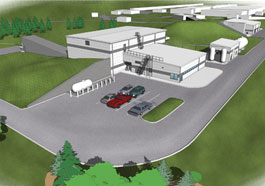
This architectural rendering shows the Hall D complex to be built as part of the CEBAF 12 GeV Upgrade at Jefferson Lab. Rendering by Hayes, Seay, Mattern & Mattern, Inc.
NEWPORT NEWS, Va. - A proposed $310-million project that will double the energy of the electron beam at the Thomas Jefferson National Accelerator Facility (Jefferson Lab) achieved a critical milestone on November 9, 2007, when the Department of Energy approved the project's performance baseline.
The approval, known as Critical Decision 2 or CD-2, Approve Performance Baseline, caps years of planning, preparation and review. According to DOE, CD-2 authorizes the final design phase to begin and is required prior to requesting a project's construction funding in a federal budget.
"The approval of CD-2 marks a significant achievement for Jefferson Lab," said Dr. Jehanne Simon-Gillo, the Acting Associate Director for the Office of Science for Nuclear Physics. "The 12 GeV Upgrade Project will allow nuclear scientists to delve deeply into the heart of the nucleon, and will permit Jefferson Lab to remain a unique international facility for decades."
CD-2 is the third step in a five-step process. The final two steps are CD-3, Approve Start of Construction (scheduled for 2008), and CD-4, Approve Start of Operations (scheduled for 2015).
The doubling of Jefferson Lab's energy, from a 6 billion-electron volts (GeV) to a 12 GeV accelerator, building of a fourth experimental hall and making improvements to the existing experimental halls, will provide scientists a one-of-a-kind tool for seeing more clearly into the nucleus of the atom and its protons and neutrons. Jefferson Lab is already the most precise facility of its kind in the world for exploring the subatomic particles known as quarks and gluons that make up protons and neutrons. In particular, the upgrade will enable scientists to address one of the great mysteries of modern physics: Why are there no single quarks?
"Securing CD-2 is a tremendous accomplishment for Jefferson Lab and the members of our 12 GeV team. This milestone further solidifies Jefferson Lab's standing as a preeminent nuclear physics research facility. Most importantly, our Nation has moved a step closer to providing scientists worldwide with a tool that will enable us to expand our knowledge of the universe," said Dr. Christoph Leemann, Jefferson Lab's Director.
To explore protons and neutrons, Jefferson Lab's accelerator propels a beam of electrons at nearly the speed of light around a massive underground "racetrack" that is 7/8 mile around. When the beam smashes into experimental targets, huge detectors collect the fragments. By studying the speed, direction and energy of the scattered fragments, scientists can learn more about protons and neutrons.

